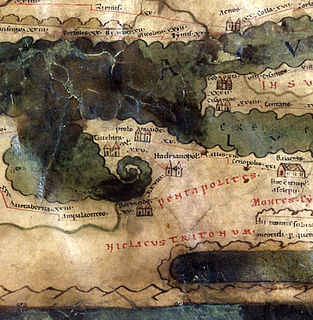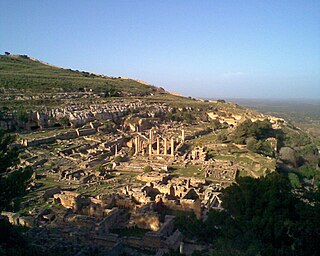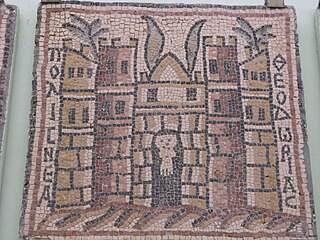 W
WBenghazi is a city in Libya. Located on the Gulf of Sidra in the Mediterranean, Benghazi is a major seaport and the second-most populous city in the country, as well as the largest city in Cyrenaica, with an estimated population of 631,555 in 2011.
 W
WBerenice, was an ancient Greek and Roman era city near Benghazi in today's Libya, named after Berenice II of Egypt. The city was located on a raised piece of land in what is now the Eastern Benghazi suburb of Sebkha Es-Selmani.
 W
WCyrene was an ancient Greek and later Roman city near present-day Shahhat, Libya. It was the oldest and most important of the five Greek cities in the region. It gave eastern Libya the classical name Cyrenaica that it has retained to modern times. Located nearby is the ancient Necropolis of Cyrene.
 W
WGasr Banat or Gasr Isawi is an archaeological site in Libya and the location of an Ancient Roman centenarium or "perched" oppidum. The area is also used as a semi-permanent camp for nomads. It was studied by Graeme Barker in 1984. Evidence from pottery found around the site suggests the date of construction was in the third century CE.
 W
WGerisa, also called Ghirza, was an ancient city of Roman Libya near the Limes Tripolitanus. It was a small village of 300 inhabitants on the pre-desert zone of Tripolitania.
 W
WLeptis or Lepcis Magna, also known by other names in antiquity, was a prominent city of the Carthaginian Empire and Roman Libya at the mouth of the Wadi Lebda in the Mediterranean.
 W
WMisrata is a city in the Misrata District in northwestern Libya, situated 187 km (116 mi) to the east of Tripoli and 825 km (513 mi) west of Benghazi on the Mediterranean coast near Cape Misrata. With a population of about 881,000, it is the third-largest city in Libya, after Tripoli and Benghazi. It is the capital city of the Misrata District and has been called the trade capital of Libya. The harbor is at Qasr Ahmad.
 W
WOea was an ancient city in present-day Tripoli, Libya. It was founded by the Phoenicians in the 7th century BC and later became a Roman–Berber colony. As part of the Roman Africa Nova province, Oea and surrounding Tripolitania were prosperous. It reached its height in the 2nd and 3rd centuries AD, when the city experienced a golden age under the Severan dynasty in nearby Leptis Magna. The city was conquered by the Rashidun Caliphate with the spread of Islam in the 7th century and came to be known as Tripoli during the 9th century.
 W
WOlbia or Theodorias was a Roman / Byzantine town between Marj and Bayda in the Cyrenaica region of modern Libya. Olbia is now mostly the archaeological site. The location's modern name is Qasr Libya, after the Islamic period castle (Qasr) on the site and Libya or Lebia as a corruption of the ancient name Olbia.
 W
WPtolemais was one of the five cities that formed the Pentapolis of Cyrenaica, the others being Cyrene, Euesperides, Tauchira/Teuchira, and Apollonia.
 W
WAlmost all Roman roads in Africa were built in the first two centuries AD. In 14 AD Legio III Augusta completed a road from Tacape to Ammaedara: the first Roman road in Africa. In 42 AD the kingdom of Mauretania was annexed by Rome. Emperor Claudius then restored and widened a Carthaginian trail and extended it west and east. This way the Romans created a continuous coastal highway stretching for 2,100 miles from the Atlantic to the Nile. In 137 Hadrian built the Via Hadriana in the eastern desert of Egypt. It ran from Antinoopolis to Berenice.
 W
WSabratha, Sabratah or Siburata, in the Zawiya District of Libya, was the westernmost of the ancient "three cities" of Roman Tripolis, alongside Oea and Lepcis Magna. From 2001 to 2007 it was the capital of the former Sabratha wa Sorman District. It lies on the Mediterranean coast about 70 km (43 mi) west of modern Tripoli. The extant archaeological site was inscribed as a UNESCO World Heritage Site in 1982.
 W
WTripoli is the capital city and the largest city of Libya, with a population of about three million people in 2019. It is located in the northwest of Libya on the edge of the desert, on a point of rocky land projecting into the Mediterranean Sea and forming a bay. It includes the port of Tripoli and the country's largest commercial and manufacturing centre. It is also the site of the University of Tripoli. The vast Bab al-Azizia barracks, which includes the former family estate of Muammar Gaddafi, is also located in the city. Colonel Gaddafi largely ruled the country from his residence in this barracks.